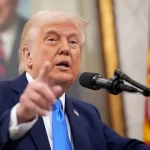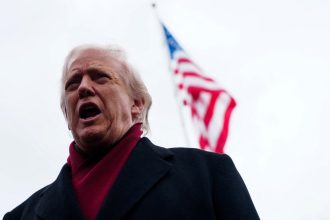Washington, D.C. – For Donald Trump, tariffs are more than just economic policy—they’re a political statement. He calls it “Liberation Day,” but for many Americans, his aggressive new trade measures could mean higher prices, economic strain, and political fallout.
On Wednesday, Trump unveiled sweeping tariffs aimed at China and the European Union, promising they would rebuild U.S. manufacturing and bring jobs back home. However, experts warn that these changes could take years, if not decades, to materialize. In the meantime, everyday Americans could feel the pinch at the grocery store, at the gas pump, and even in their retirement savings.
The Reality of Tariffs: Who Pays the Price?
Despite Trump’s rhetoric, tariffs don’t come out of foreign governments’ pockets. Importers pay them, and they often pass those costs on to consumers. A recent Reuters/Ipsos poll shows that 70% of Americans—including 62% of Republicans—believe tariffs will drive up prices on essential goods.
The White House insists that Trump’s policies will ultimately make America stronger. “His only concern is the welfare of the American people,” said White House spokesman Kush Desai. But that assurance offers little comfort to small business owners and families already struggling with rising costs.
Political Risks Looming Large
With midterm elections just 18 months away, Trump’s Republican Party is walking a fine line. If the tariffs lead to a downturn or inflation spikes, voter backlash could cost them control of Congress. Even some Republican lawmakers are pushing back—four GOP senators joined Democrats in a 51-48 vote to roll back tariffs on Canada.
Meanwhile, early signs of voter dissatisfaction are emerging. In Wisconsin, a liberal candidate won a key Supreme Court seat, a setback for Trump and his ally Elon Musk, who backed the conservative opponent. In Florida, Republican candidates won by smaller margins than expected, raising concerns within the party.
A Fragile Economy on the Edge
The U.S. economy under Biden had been relatively stable, with 3% growth, unemployment near 4%, and inflation under control. But since Trump’s tariff push, consumer and business confidence have taken a hit.
“This is a really bad idea politically,” said Philip Luck, an economist and former State Department official. “Trade retaliation could hit U.S. businesses hard, and that’s not something voters will ignore.”
Even among small business owners, opinions are split. Drew Greenblatt, a Baltimore-based manufacturer, says tariffs are helping him win orders. But for Michelle Lim Warner, who owns a boutique wine shop in Washington, D.C., Trump’s tariffs on European imports are devastating. “Who is going to pay $75 for what was a $25 bottle of wine?” she asked.
The Big Question: Will Trump’s Bet Pay Off?
Trump has made bold promises before and survived political storms that would have sunk most politicians. Barbara Trish, a political scientist at Grinnell College, put it simply: “How many times have people thought, ‘This is the last straw’? And yet, he’s still standing.”
The real test will come in November 2026, when voters decide if Trump’s vision of “prosperity” aligns with the reality of their wallets.








